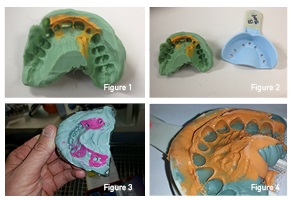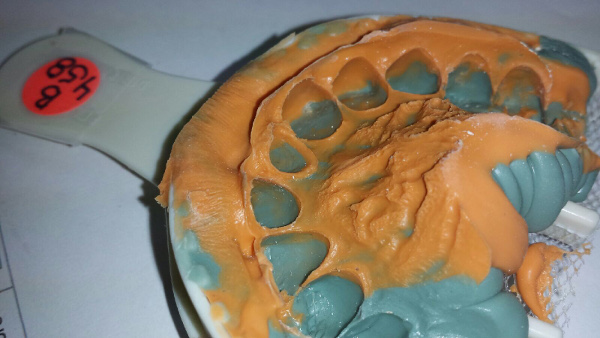With the New Year now well under way, it is my hope that 2016 will be a year of growth, prosperity, and happiness for us all! I would like to express my appreciation to all of our Mentor/Instructors, students, PAC members and team at Corr Dental Designs for an incredibly successful year in 2015.
In that same spirit of appreciation and continued learning, I would like to review a few of the basics that are critical to the predictability of successful results in the dental laboratory. Certainly, one of the most crucial components to a successful insertion of a crown, veneer, implant, bridge or any fixed restoration is an accurate impression. In the laboratory, we look at each impression before it is poured up. The obvious concerns are bubbles in the impression or undetectable margins. There are times, however, when potential problems cannot be detected without pouring the model. One of the “yellow flags” that I see (which often times goes unaddressed) is the impression trays we receive with exposed plastic or metal inside the tray where either soft tissue or tooth structure has pressed right through the impression material and hit the tray internally (Figure 1). Although we will typically proceed with the case, unless the tray exposure actually hits a margin, there is a risk that some type of distortion may occur and that accuracy might be compromised. The simple truth is that hard plastic and or metal impression trays do not flex, whereas gingival tissue usually will. If the distortion is significant, the crown will not fit. If the tray exposure occurs in the retro molar area, the crowns will likely be high in occlusion. Although rare, another potential problem is that the impression does not adhere to the tray (Figure 2). Another potential area of concern, and likely even more costly, occurs when the impressions we receive for implants are incomplete in the most critical areas around the impression copings (Figure 3). Closed tray impressions will arrive without impression copings in place. Open tray impressions will come sometimes without sufficient material surrounding the coping. When this occurs it is possible that when the analog is tightened down the impression coping could rotate because it is not stable, thus resulting in a rotated implant restoration. We also receive implant cases from time to time without critical information such as manufacturer’s identity, implant size, and internal configuration specs. Any one of these concerns will not only hold up a case but each scenario can reduce the likelihood of a precise fit.
Another potential area of concern, and likely even more costly, occurs when the impressions we receive for implants are incomplete in the most critical areas around the impression copings (Figure 3). Closed tray impressions will arrive without impression copings in place. Open tray impressions will come sometimes without sufficient material surrounding the coping. When this occurs it is possible that when the analog is tightened down the impression coping could rotate because it is not stable, thus resulting in a rotated implant restoration. We also receive implant cases from time to time without critical information such as manufacturer’s identity, implant size, and internal configuration specs. Any one of these concerns will not only hold up a case but each scenario can reduce the likelihood of a precise fit.
With regard to impressions used for diagnostics, important points to remember include making sure to capture the vestibule and palatal area to ensure proper orientation of the preps guides and temporary matrices which are derived from the wax up (Figure 4). It is essential that they accurately duplicate the maxillary and mandibular arches or those vital tools will be compromised.
In that same spirit of appreciation and continued learning, I would like to review a few of the basics that are critical to the predictability of successful results in the dental laboratory. Certainly, one of the most crucial components to a successful insertion of a crown, veneer, implant, bridge or any fixed restoration is an accurate impression. In the laboratory, we look at each impression before it is poured up. The obvious concerns are bubbles in the impression or undetectable margins. There are times, however, when potential problems cannot be detected without pouring the model. One of the “yellow flags” that I see (which often times goes unaddressed) is the impression trays we receive with exposed plastic or metal inside the tray where either soft tissue or tooth structure has pressed right through the impression material and hit the tray internally (Figure 1). Although we will typically proceed with the case, unless the tray exposure actually hits a margin, there is a risk that some type of distortion may occur and that accuracy might be compromised. The simple truth is that hard plastic and or metal impression trays do not flex, whereas gingival tissue usually will. If the distortion is significant, the crown will not fit. If the tray exposure occurs in the retro molar area, the crowns will likely be high in occlusion. Although rare, another potential problem is that the impression does not adhere to the tray (Figure 2).
 Another potential area of concern, and likely even more costly, occurs when the impressions we receive for implants are incomplete in the most critical areas around the impression copings (Figure 3). Closed tray impressions will arrive without impression copings in place. Open tray impressions will come sometimes without sufficient material surrounding the coping. When this occurs it is possible that when the analog is tightened down the impression coping could rotate because it is not stable, thus resulting in a rotated implant restoration. We also receive implant cases from time to time without critical information such as manufacturer’s identity, implant size, and internal configuration specs. Any one of these concerns will not only hold up a case but each scenario can reduce the likelihood of a precise fit.
Another potential area of concern, and likely even more costly, occurs when the impressions we receive for implants are incomplete in the most critical areas around the impression copings (Figure 3). Closed tray impressions will arrive without impression copings in place. Open tray impressions will come sometimes without sufficient material surrounding the coping. When this occurs it is possible that when the analog is tightened down the impression coping could rotate because it is not stable, thus resulting in a rotated implant restoration. We also receive implant cases from time to time without critical information such as manufacturer’s identity, implant size, and internal configuration specs. Any one of these concerns will not only hold up a case but each scenario can reduce the likelihood of a precise fit.With regard to impressions used for diagnostics, important points to remember include making sure to capture the vestibule and palatal area to ensure proper orientation of the preps guides and temporary matrices which are derived from the wax up (Figure 4). It is essential that they accurately duplicate the maxillary and mandibular arches or those vital tools will be compromised.
We consider our working relationship with you and your practice paramount to our success. Our greatest desire is to provide the most accurate fitting, proper functioning, aesthetic restorations possible. We appreciate your constant vigilance in these areas of concern. This will aid us in assuring that our best efforts will bring us all superior results.
Please call me with any questions you might have or to discuss a case at (916) 786-6740 or email me at [email protected]. Visit the Pacific Aesthetic Laboratory Group online at www.pacificaesetheticdentalstudio.com.


